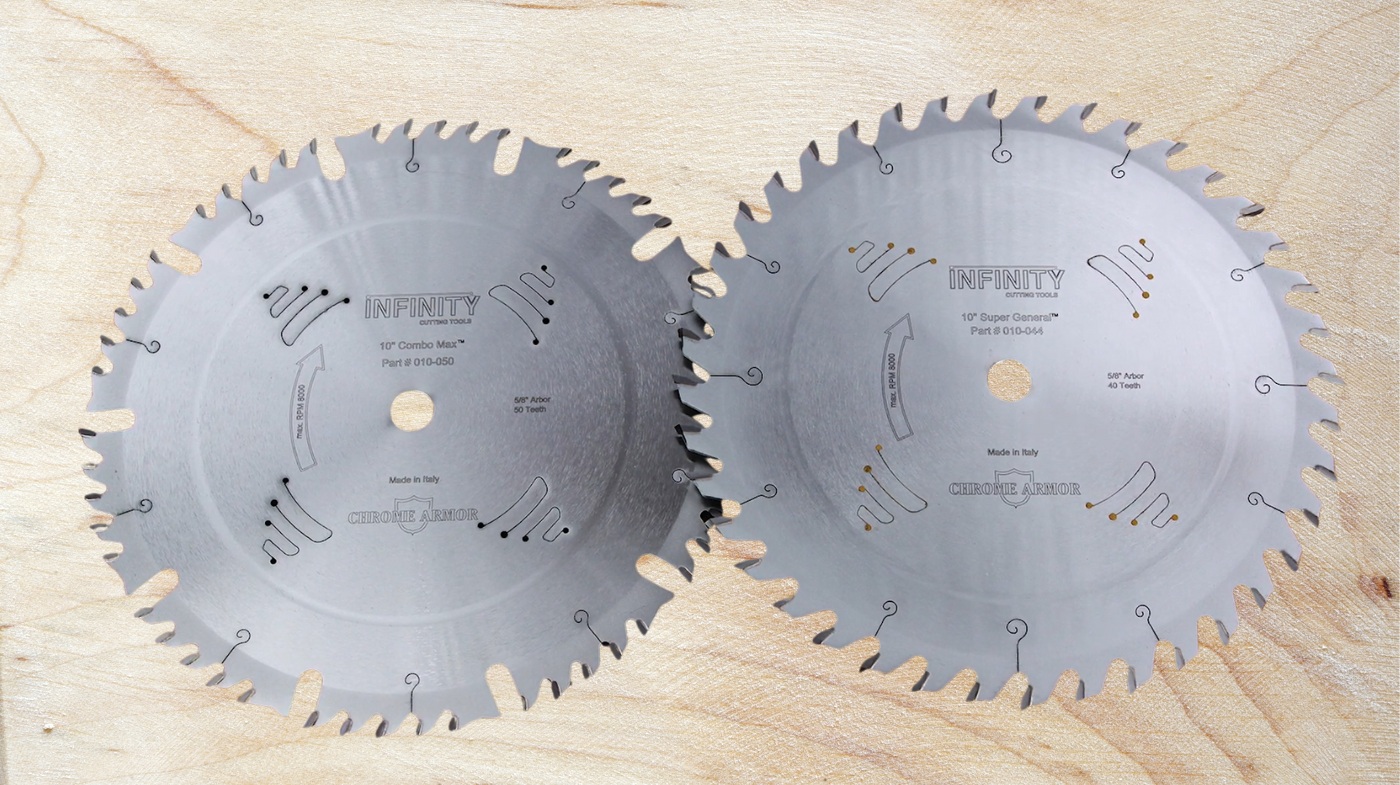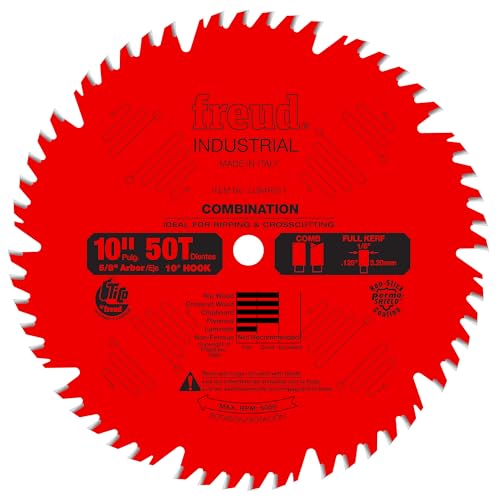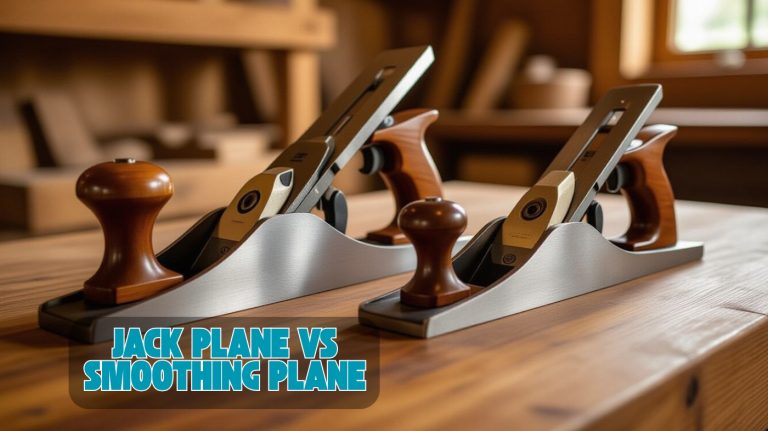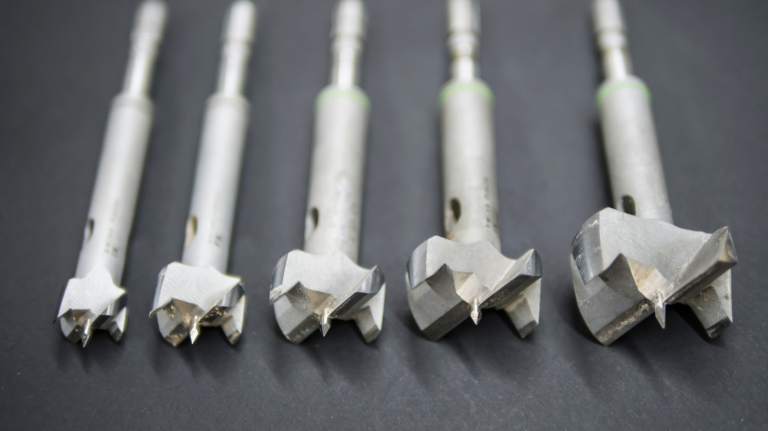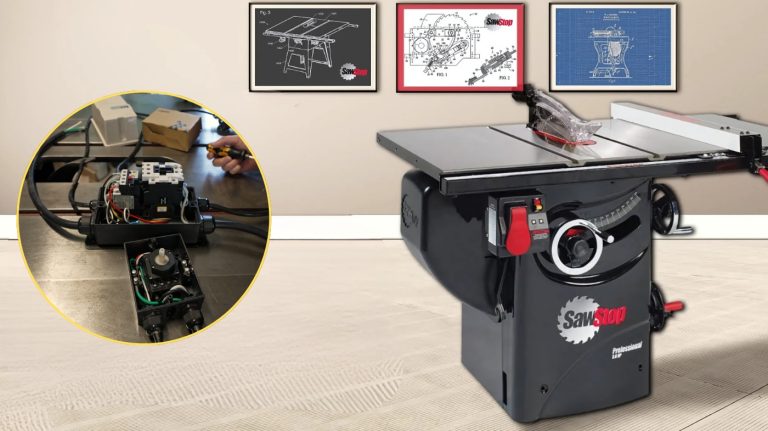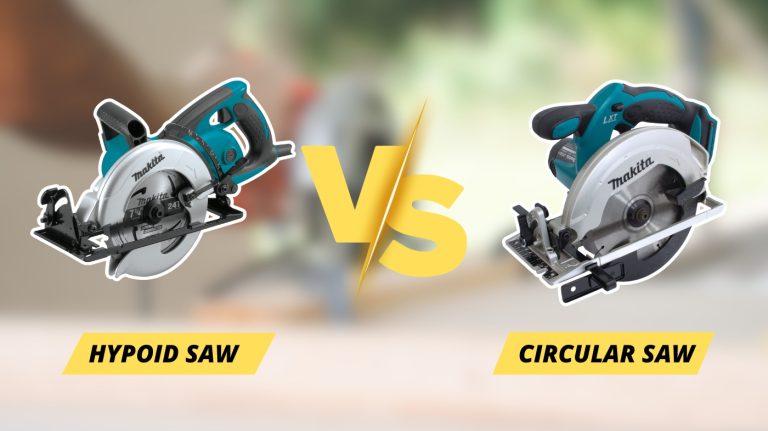Combination vs General Purpose Saw Blade: Which Cuts Best?
If you need versatility and cleaner cuts on thicker hardwoods, combination saw blades outperform general purpose ones by featuring a specialized tooth pattern (4 ATB + 1 FTG/TCG) with about 50 teeth for balanced crosscutting and ripping.
They handle dense materials better, reduce tear-out, and last longer due to durable carbide tips and larger gullets.
General purpose blades suit thinner, softer materials but sacrifice finish quality and wear faster. Understanding these technical differences helps optimize your workflow and cut quality.
- Advanced Tooth Configuration – Combines one flat tooth for efficient ripping with four alternate top…
- Premium TiCo Carbide Blend – Features a high-density TiCo combination blend that maximizes cutting…
- Efficient Chip Removal – Large gullets positioned in front of flat-top raker teeth enable fast…
- Diablo 10-Inch 40-Tooth ATB General Purpose Saw Blade
- Diablo 10-Inch 40-Tooth ATB General Purpose Saw Blade
- Diablo 10-Inch 40-Tooth ATB General Purpose Saw Blade
Key Takeaways
- Combination blades have a “4 & 1” tooth pattern with 40-60 teeth for balanced ripping and crosscutting, while general purpose blades have simpler tooth designs.
- Combination blades excel on thick hardwoods and engineered wood, offering cleaner cuts and less tear-out than general purpose blades suited for thinner materials.
- Combination blades provide smoother finishes and flat bottom kerfs ideal for joinery; general purpose blades often leave rougher edges and more splintering.
- Using combination blades reduces blade changes and improves workflow efficiency, whereas general purpose blades require more frequent replacements and switches.
- Combination blades cost more upfront but last longer and handle diverse materials safely; general purpose blades are cheaper but wear faster and fit lighter tasks.
Combination and General Purpose Saw Blade Comparison
| Aspect | Combination Blade | General Purpose Blade |
|---|---|---|
| Tooth Count | 40-60 teeth (typically 50) | Around 40 teeth |
| Tooth Pattern | “4 & 1” pattern – 4 ATB + 1 FTG/TCG | Simple ATB pattern |
| Best Material Thickness | Thick materials over 1¼ inches | Thin materials under 1¼ inches |
| Cut Quality | Cleaner cuts, less tear-out | Rougher finish, more splintering |
| Material Suitability | Hardwoods, MDF, engineered wood | Plywood, softwoods, laminated wood |
| Versatility | Excellent – handles both ripping and crosscutting | Good – basic cuts on lighter materials |
| Durability | Longer lasting – carbide tips, multiple sharpenings | Shorter lifespan – wears faster |
| Cost | Higher upfront cost but better long-term value | Lower initial cost but more frequent replacements |
| Workflow Efficiency | Reduces blade changes – one blade for multiple tasks | Requires more frequent blade switching |
| Ideal Use Cases | Professional work, thick lumber, mixed materials | Light-duty tasks, thin stock, budget projects |
Definitions and Design Differences
Although saw blades come in various types, combination saw blades stand out by integrating features for both ripping and cross-cutting tasks, so you won’t need to switch blades when working on different cuts.
These blades use a “4 & 1” tooth pattern—four Alternate Top Bevel (ATB) teeth for clean cross-cuts, followed by one Flat Top Grind (FTG) tooth optimized for efficient ripping. Their tooth design can be compared to specialized bandsaw blades that enhance cutting efficiency through optimized tooth pitch designs.
Typically, they’ve 40 to 60 teeth, balancing cut quality and speed. The carbide teeth combine hardness for sharpness with impact resistance to extend blade life.
Tooth bevels often range from 15º to 30º, affecting cut aggressiveness. Larger gullets accommodate wood chip removal during ripping, providing efficient wood removal.
This specialized design supports versatility and precision, making combination blades a practical choice for woodworking projects requiring both types of cuts without blade changes.
Material Suitability Comparison
When working with thick materials, you’ll want a blade designed for durability and sustained cutting power to prevent overheating and wear.
Combination blades, with their alternating teeth and large gullets, are particularly effective in handling such tasks due to their efficient chip ejection.
For thin or delicate materials, a lighter-duty blade with finer tooth configurations offers cleaner cuts and reduces chipping.
Thick vs Thin Materials
Since cutting thick and thin materials demands different blade characteristics, selecting the right saw blade type is essential for peak performance. Combination blades excel with thick materials over 1 ¼” due to about 50 teeth and medium-sized gullets, efficiently handling hardwoods and engineered boards.
General purpose blades, with smaller gullets and fewer teeth, suit thin materials under 1 ¼”, like plywood and softwood, offering smoother cuts and faster switching between rip and crosscut.
Consider these points:
- Combination blades balance ripping and crosscutting for thick stock.
- General purpose blades provide versatility for thinner materials.
- Thicker materials strain general purpose blades more due to tooth design.
- For thin materials, general purpose blades deliver adequate finish and speed.
Choose accordingly to match material thickness and project demands. Additionally, using lubrication on saw blades can improve cutting efficiency and extend blade life when working with different material thicknesses.
Durable vs Light-Duty Use
Choosing the right saw blade also depends on whether your project demands durable, heavy-duty performance or lighter, less intense use.
Combination blades feature sharp, durable teeth with deep gullets and chamfered raker teeth, enhancing their longevity and resistance to wear.
They excel at cutting thick hardwoods, melamine, MDF, and even non-ferrous metals, making them ideal for demanding tasks requiring consistent finish quality.
Their ATB-R tooth pattern produces an almost flat bottom kerf, which is especially useful for dadoes and grooves. However, using these blades on dense hardwoods requires caution to prevent table saw overloading that can strain the motor.
In contrast, general-purpose blades suit light-duty jobs like cutting plywood, softwoods, and laminated wood, offering good finish quality without excessive tearout. They’re easier to maintain, cost-effective, and perfect for making jigs or shop furniture.
If your work involves heavy materials or frequent cutting, go for a combination blade; for less intense applications, a general-purpose blade provides versatility and simplicity.
Cutting Performance and Quality Analysis
You’ll notice combination blades deliver cleaner cuts with minimal tear-out, especially on crosscuts, thanks to their higher tooth count and specialized geometry.
The Combo Max blade, with its 50 teeth and unique chamfer Drakkar tooth design, excels at producing almost perfectly flat bottom cuts, ideal for quick joinery applications. In contrast, general purpose blades may leave more splintering, particularly on delicate materials.
Understanding how each blade handles both crosscut and rip quality will help you choose the right tool for precise, efficient work.
Higher tooth count blades generally provide smoother finishes that reduce the need for sanding and improve overall cut quality.
Cut Cleanliness Comparison
When evaluating cut cleanliness, understanding tooth geometry plays a crucial role in appraising saw blade performance.
Combination blades feature a mix of Alternate Top Bevel (ATB) and raker teeth, producing cleaner crosscuts by scoring fibers without being overly aggressive. They often have a minimum of 24 teeth to ensure clean and accurate cuts on laminate flooring.
In contrast, general purpose blades have simpler tooth patterns that remove more material but yield rougher finishes.
Consider these key points:
- Combination blades reduce chipout and burning on sensitive materials like melamine, improving cut quality. Notably, teeth geometry affects the tradeoff between cut quality and ripping speed, influencing blade choice.
- Thin kerf combination blades remove less material, enhancing precision and reducing heat buildup.
- General purpose blades excel in speed but compromise smoothness, requiring more finishing.
- Combination blades handle diverse materials with cleaner edges, minimizing sanding effort.
You’ll find combination blades deliver superior cut cleanliness for varied applications.
Tear-Out and Splintering
Although both combination and general purpose blades cut wood effectively, their resistance to tear-out and splintering varies considerably due to tooth design and material compatibility.
Combination blades feature about 50 teeth, including alternating top bevel (ATB) and chamfered raker or triple chip grind (TCG) teeth, which reduce tear-out on thicker stock and dense materials like MDF. Their deeper gullets improve chip removal, reducing heat and splintering. Full-kerf blades, with teeth that are .125 or thicker, are especially suitable for tough cuts and help maintain cutting quality under demanding conditions. Using the appropriate blade height adjustment ensures clean cuts and reduces the risk of chipping and tear-out.
In contrast, general purpose blades with roughly 40 ATB teeth excel on thinner materials under 1¼” but tend to cause more tear-out on thicker or veneered stock due to smaller gullets and fewer teeth.
Combination blades maintain sharpness longer, minimizing splintering risks, while dulling general purpose blades increase rough edges and tear-out, especially on hardwoods and laminates.
Crosscut and Rip Quality
Since cutting performance directly impacts your project’s finish and efficiency, understanding the crosscut and rip quality differences between saw blade types is essential.
Combination blades, with their 50-tooth ATB-R pattern, offer smoother crosscuts and better chip ejection on thicker stock, but slower feed rates improve finish. These blades often feature a mix of flat top raker and ATB teeth, which can produce tear-out on crosscuts as they dull.
General purpose blades, typically 40 teeth, cut faster with less scoring but slightly rougher hardwood edges. They commonly have an all ATB tooth configuration with a 10° hook angle, which helps in providing a smoother cut and reducing noise.
For ripping, combination blades reduce binding and burning with deep gullets and rakers, maintaining sharpness on abrasive materials.
General purpose blades excel in fast, aggressive cuts but dull quicker on mixed materials.
Consider these key points:
- Combination blades balance clean crosscuts and efficient ripping.
- General purpose blades prioritize speed over finish quality.
- Tooth design affects chip clearance and heat buildup.
- Material type influences blade longevity and cut smoothness.
Durability and Maintenance Considerations
Because durability directly impacts both performance and cost-efficiency, understanding the maintenance needs and construction of saw blades is essential for optimizing their lifespan.
Combination blades use high-quality carbide teeth and precise laser-cut builds, which resist wear and enable multiple sharpenings.
Regular cleaning, proper storage, and alignment also help maintain peak performance. You can save long term by investing in blades designed for durability and scheduling timely sharpening.
Additionally, pitch or sap build-up is a common issue that can significantly reduce blade efficiency if not regularly cleaned. Selecting blades with appropriate blade materials also ensures better resistance to chipping and longer service life.
| Factor | Combination Blade | General Purpose Blade |
|---|---|---|
| Material | High-carbide, laser-cut | Lower carbide, standard steel |
| Sharpening | Multiple cycles, $10-$20 cost | Less frequent, often replace |
| Durability | Resists chipping and wear | Prone to faster dulling |
| Maintenance | Requires cleaning and alignment | Minimal upkeep |
Applications and Ideal Use Cases
Understanding the durability and maintenance of combination saw blades sets the stage for recognizing where these blades excel in practical use.
You’ll find these blades perfect for handling thicker lumber over 1 ¼ inches and switching seamlessly between rip and crosscuts without changing blades.
Their tooth pattern typically features an Alternate Top Bevel (ATB) design that balances cut quality for multiple materials and cut types.
Moreover, selecting the right blade often involves considering safety features to ensure optimal performance and user protection.
This versatility makes them invaluable in cabinetry, furniture manufacturing, and mixed-material projects. Consider these ideal use cases:
- General woodworking projects needing both rip and cross cuts.
- DIY tasks requiring efficient, clean cuts across varied materials.
- Professional settings where minimizing blade changes saves time and costs.
- Fabricating jigs, sleds, and shop furniture from hardwoods and plywood.
Combination blades outperform general purpose blades when working on thicker, mixed materials, providing cost-effective, precise cuts while reducing labor and blade inventory.
Tooth Profiles and Gullet Design
When you choose a combination saw blade, you get a tooth profile designed to balance ripping and crosscutting, typically featuring an ATBR (Alternate Top Bevel with Raker) pattern.
This profile alternates beveled teeth that score fibers cleanly during crosscuts with flat raker teeth that efficiently clear chips, reducing binding and heat buildup.
The grouped teeth are separated by large gullets positioned after every four or five teeth, which enhances chip clearance and maintains a moderate ripping speed without sacrificing cut smoothness.
Proper blade maintenance, including regular inspection and tension adjustment, helps preserve the efficiency of these tooth profiles and prevents issues like blade wobbling.
In contrast, general purpose blades use simpler tooth patterns like ATB, FTG, or TCG, with smaller, evenly spaced gullets for consistent chip removal across diverse materials.
These blades are generally cheaper and do not follow the best design practices that combination blades incorporate.
Thickness Range and Material Compatibility
How thick should your saw blade be for the job at hand? Combination blades typically measure around 1.6 mm thickness, balancing durability and precision for hardwoods, plywood, and laminates.
General purpose blades often feature thinner kerfs under 3.2 mm, reducing material waste and enabling smoother cuts on MDF and plastics.
Consider these key points:
- Thicker blades (≥1.6 mm) resist warping, ideal for ripping dense, thick stock.
- Thinner blades (<3.2 mm) flex less for fine crosscuts but may bend on heavy loads.
- Tooth composition, like carbide with Teflon coating, enhances cut quality across mixed woods.
- Blade thickness must match your saw’s arbor size and wheel diameter for ideal fit and safety.
- Features such as black Teflon coating help reduce friction and increase blade durability during prolonged use.
Impact on Workflow and Efficiency
You’ll notice that reducing blade switches with combination blades saves valuable time when cutting diverse materials.
However, general purpose blades often deliver faster cuts on thinner stock, boosting overall speed for repetitive tasks.
Balancing cutting speed and material flexibility directly impacts your workflow efficiency and project timelines.
Blade Switching Frequency
Why does blade switching frequency matter so much in your workflow? Frequent blade changes interrupt your momentum, causing downtime and reducing overall productivity.
Each switch demands adjustments and calibration, eating into valuable work time. You also face increased maintenance requirements and the complexity of managing multiple blade inventories.
To optimize efficiency, consider these factors:
- Downtime: Repeated blade switching disrupts continuous operation, lowering throughput.
- Maintenance: More frequent changes mean heightened tool upkeep and calibration.
- Training: Operators must master different blades, complicating workflow and increasing errors. Additionally, precise tuning of natural frequencies through roll-tensioning methods can prevent resonance, enhancing blade performance and reducing the need for frequent blade adjustments.
- Inventory: Managing various blades complicates storage and tracking, adding logistical burdens.
Cutting Speed Variations
Although cutting speed varies considerably between general purpose and combination saw blades, understanding these differences helps you optimize workflow efficiency for specific materials and tasks.
General purpose blades, with around 40 teeth and larger gullets, cut faster on thinner boards like plywood, reducing cycle times on routine cuts. These blades often feature full kerf widths, which provide stability during faster feedrates.
Combination blades, featuring about 50 teeth with alternating ATB and flat or triple chip grind teeth, cut slower but deliver smoother finishes on thicker lumber over 1 ¼”. Their slower feed rates offset by fewer blade changes improve workflow continuity when handling mixed materials.
Choosing thin kerf versions can increase feed speeds and reduce burning. Matching blade speed to material density and thickness ensures faster, cleaner cuts, minimizing downtime and blade wear while balancing productivity with cut quality.
Material Handling Flexibility
A blade’s tooth configuration directly affects how it handles different materials, impacting both workflow and efficiency. Combination blades mix ATB and FTG or TCG teeth with deep gullets, enhancing chip clearance and durability.
General purpose blades mainly use ATB teeth with smaller gullets, limiting their efficiency on thick or dense stock. Here’s what this means for you:
- Combination blades adapt smoothly between ripping and crosscutting diverse materials, reducing blade swaps.
- They handle thicker stock and mixed materials like hardwood, MDF, and plastics effectively.
- General purpose blades perform well on thin plywood but struggle with complex, multi-material projects.
- Using combination blades streamlines workflow, cuts downtime, and boosts efficiency in multi-stage projects.
Technical Specifications and Safety Features
When selecting a combination saw blade, understanding its technical specifications and safety features is crucial for peak performance and secure operation.
These blades range from 7 to 16 inches in diameter, with 40 to 80 teeth, commonly 50 to 70, featuring an ATB+R tooth pattern for efficient ripping and crosscutting.
Their consistent manufacturing quality ensures tolerances of .002 inches or less, contributing to precise and reliable cutting.
They fit standard 5/8-inch arbors and handle wood, MDF, particleboard, and nonferrous metals. Safety-wise, many support SawStop technology to prevent accidents.
Expansion slots and copper plugs reduce vibration and overheating, while large gullets improve chip clearance, reducing kickback risk. Durable, sharp teeth maintain cutting precision and safety over time.
This combination of specs and safety elements ensures reliable, smooth cuts and stable operation during diverse woodworking tasks.
Cost Effectiveness and Long-Term Value
Understanding the technical specifications and safety features of saw blades sets the stage for evaluating their cost effectiveness and long-term value. When choosing between combination and general purpose blades, consider these key points:
- Combination blades offer versatility by cutting various materials and thicknesses, reducing the need for multiple blades and replacements. Their number of teeth balances cutting speed and smoothness, making them suitable for diverse woodworking tasks.
- Their durable teeth maintain sharpness through multiple sharpenings, delivering long-term savings and consistent performance.
- General purpose blades are budget-friendly for thinner materials and basic cuts but wear out faster and require more frequent replacements.
- Combination blades enhance workflow efficiency by supporting ripping and crosscutting in one blade, making them a better investment for frequent or complex woodworking tasks.
Frequently Asked Questions
Can Combination Blades Be Safely Used on Metal Without Damaging the Saw?
You shouldn’t use combination blades on metal without risking damage. These blades are designed for wood and softer materials, so cutting metal can cause overheating, dull teeth, and stress your saw’s motor.
Metal requires specialized blades made of harder materials like carbide or diamond to handle its toughness safely and efficiently.
Using the wrong blade increases injury risk and shortens your saw’s lifespan, so always choose the correct blade for metal cutting.
How Do Blade Sound Levels Compare Between Combination and General Purpose Blades?
You’ll notice that blades with advanced tooth spacing, dampening slots, and thinner kerfs reduce vibration and noise, delivering quieter cuts around 72-73 dB(A).
You’ll find simpler blades without these features produce steady, louder noise levels near 83-88 dB(A). You’ll experience more whistling and singing if blades lack proper tensioning or noise-optimized design.
Are There Specific Brands Known for Superior Combination Saw Blade Quality?
You’ll find brands like Freud Tools and Irwin Marples leading in combination saw blade quality due to their advanced TiCo™ Hi-Density Carbide and alternate tooth bevel designs that guarantee precision and durability.
DeWalt’s ToughCoat™ finish also offers reduced friction and extended blade life. Forrest blades, made with carbon steel for easy sharpening, provide longevity.
These brands combine innovative materials and coatings, delivering superior cutting performance across various woodworking tasks.
What Blade Storage Methods Best Preserve Tooth Sharpness and Alignment?
Want to keep your saw blade teeth sharp and perfectly aligned? Store each blade separately using protective sleeves or covers to prevent metal-on-metal contact that causes chipping.
Use wall-mounted racks with individual slots or knife block-style holders on soft surfaces, avoiding stacking or banging. Keep blades in a cool, dry environment and clean them thoroughly before storage. These steps reduce corrosion, wear, and maintain cutting precision for longer tool life.
Can Combination Blades Be Resharpened at Home or Require Professional Service?
You can resharpen combination blades at home if you have the right jig or sharpener and understand tooth angles and filing techniques. However, their varied tooth configurations make home sharpening more complex and time-consuming.
For precise, consistent results and to maintain performance, professional services use advanced machinery and expertise. If you lack sharpening experience or want to save time, it’s smarter to rely on professionals for durable, accurate blade maintenance.
Invest in Quality: Better Cuts Start with the Perfect Saw Blade
When choosing between combination and general-purpose saw blades, you’re really weighing precision against versatility. While a general-purpose blade offers a “jack-of-all-trades” convenience, a combination blade subtly elevates your cutting quality and efficiency, especially on varied materials.
By understanding their design nuances and performance traits, you’ll avoid the frustrating compromises that come with the wrong choice.
Investing in the right blade isn’t just about cost—it’s about releasing smoother, safer, and more reliable workflow every time.
- 10 Inch 50-Tooth Combination Saw Blade, .098″ Kerf, Hook Angle 15°, Plate .071″ with 5/8″ Arbor,…
- Combination blade is ideal for ripping and crosscutting wood & wood composites with the goal of a…
- Each set of 5 teeth is separated by a large gullet
- (D) diameter: 10 (250mm)
- Teeth: 60
- (D) Bore: 5/8
Last update on 2025-12-21 / Affiliate links / Images from Amazon Product Advertising API

